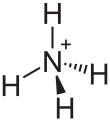Cohesion
The bond (also bond value , covalency ) designates the number of atomic bonds that an atom of a chemical element forms within a molecule . In the Lewis or structural formula it is expressed by the number of valence lines, starting from an atom.
For example, the two carbon atoms (C) in ethane (C 2 H 6 ) are tetravalent because they have four bonds. The hydrogen atoms (H) are one bond with one bond. In ammonia (NH 3 ) the nitrogen atom (N) is three-bonded and the hydrogen atoms are single-bonded. In formaldehyde (CH 2 O) there is a double bond : here the carbon is four-bonded again, both hydrogen atoms are one-bond and the oxygen (O) has two bonds.

The cohesiveness is mainly determined by the number of singly occupied atomic orbitals (AO). A singly occupied orbital is an orbital in which there is only one electron . Hydrogen has a singly occupied s orbital (1s 1 ), which is why it is monovalent. In the case of nitrogen, the three singly occupied p orbitals of the second shell (2p 3 in the configuration 1s 2 , 2s 2 , 2p 3 ) are responsible for the fact that it is three-bonded.
However, it must be taken into account here that there are also elements that provide more bonds through hybridization , so that the number of simply occupied hybrid orbitals counts here. An example of this is carbon, which in the ground state would be double-bonded due to its two singly occupied p orbitals (1s 2 , 2s 2 , 2p 2 ). However, before the bond, the carbon is excited to the valence state (1s 2 , 2sp 3 ) in which there are 4 singly occupied sp 3 orbitals, so that it can form four bonds , i.e. it is four-bonded.
Atoms with free electron pairs are another exception . Here, these free electron pairs can be used for a bond ( coordinative bond ) by introducing the two electrons of the electron pair into the bond. An example here is nitrogen, which in the ammonium ion (NH 4 + ) binds to four hydrogens, because it has entered into a fourth bond with its free electron pair, i.e. it has four bonds.
Individual evidence
- ↑ Entry on bond number . In: IUPAC Compendium of Chemical Terminology (the “Gold Book”) . doi : 10.1351 / goldbook.B00705 Version: 2.3.



